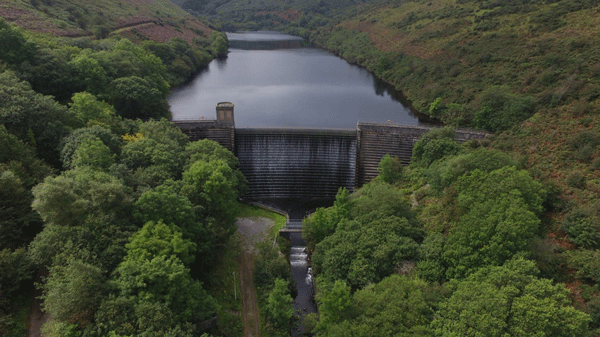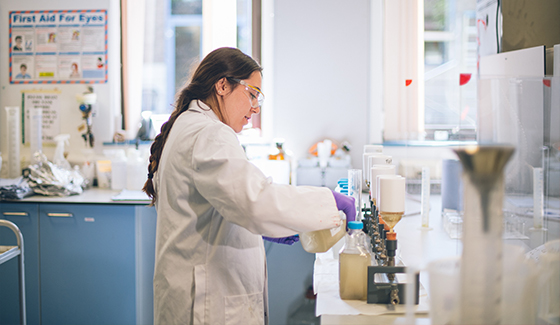- Home
- Our purpose
- Water supply
- Water treatment
Why do we treat water?
All our water comes from natural groundwater sources and reservoirs. It must be treated before human consumption to remove contaminants like bacteria and pollution.
This critical service allows us to provide a safe and reliable water supply for our customers which fully meets the standards of The Water Supply (Water Quality) Regulations 2000.
Where does our water come from?
Around 75% of our water comes from deep underground (groundwater sources) in Dorset and Wiltshire.
The remainder comes from our 11 surface water reservoirs, which are fed by streams and rivers mainly in the Somerset area.

Treating water from groundwater sources
Groundwater is found underground in cracks and spaces in soil, sand and rock, which is naturally replenished by surface water from rain, streams and rivers. These rocks, which are also known as aquifers, can store billions of litres of water.
Groundwater is filtered by the Earth itself, so it is of a naturally high quality. This means it usually requires less complex and energy-intensive treatment compared to water from reservoirs and rivers.
Watch this video or read the information below to learn about how we treat groundwater from boreholes and springs.
Borehole treatment
We use boreholes to access water that is locked deep underground. They are drilled using specialist equipment and are essentially deep shafts that can extend over 100m into the Earth.
The large steel tubes are set deep underground. This keeps any shallow contamination and ingress out of the borehole.
They extract water from our principal aquifers, which are known as the upper chalk. These aquifers contain lots of clean water. Slightly below the upper chalk is another aquifer. This provides a top-up of water to the chalk during dry summer months.
Small screens are inserted into the base of boreholes, and then gravel is added around them to keep really coarse material out.
Once the water has been extracted, we measure its turbidity to find out how many particles (such as fine sand or chalk) are in it.
Before water is supplied to customers’ homes, we treat it with a small amount of chlorine to ensure it is safe to drink.
Spring treatment
We use springs to extract water that is close to the surface. Spring chambers have a number of culverts, each of which creates a different stream of spring water inside the chamber.
As springs are closer to the surface, they don’t provide the same natural filtration as boreholes, so spring water needs a bit more treatment.
Once treated at the spring site, the water is pumped to underground storage reservoirs, ready to be supplied to customers.
Treating water from reservoirs
Reservoirs store water from rain that falls during the wetter parts of the year in preparation for when there is less rain. They have been built for over 5,000 years.
Reservoir water needs a higher level of treatment than groundwater, so we use several different processes to purify it to the high quality required by law.
Watch this video or read the steps below to learn about how we treat water from our reservoirs.
- Firstly, we manage the surrounding landscape to ensure the water that enters our reservoirs is of the highest possible quality.
- The raw water flows through extremely fine filters to remove algae, insects, leaves, branches and other objects.
- Before it is treated, we test the raw water which gives us an idea of how much chemicals are needed for treatment.
- Next, the water is fed into a chamber where chemicals are added to make any particles stick together, and air is pumped in to force them to the surface where they are removed.
- The water then flows into fine sand filter beds which trap any remaining particles before it goes through a filtration process which removes any pesticides and impurities.
- After filtration, the water receives a dose of chlorine and sometimes undergoes UV treatment to kill any remaining germs and bacteria.
- Finally, the clean water flows into a storage reservoir and is supplied to customers.
Monitoring water quality
We regularly monitor the quality of our drinking water to ensure our treatment processes are delivering excellent standards.
We take 50,000 samples every year to ensure our water supply is of the highest quality – find out more about how and why we take samples and what we test for.
The Drinking Water Inspectorate (DWI) also monitors the quality of our drinking water to ensure we meet standards and regulations.

Powers of entry and preventing contamination
Water companies are responsible for enforcing regulations that protect the quality of the water supply.
These regulations prevent contamination, waste and misuse of water and we have statutory rights to enter premises or land to investigate compliance with the Water Supply (Water Fittings) Regulations 1999.
We also have powers of entry for monitoring the wholesomeness of our water supply and this may involve taking water samples or carrying out surveys.
We’ll always call at a reasonable time and give customers prior notice, except when we are dealing with emergency incidents. If we fail to provide the appropriate notice to customers, they have the right to refuse entry.
